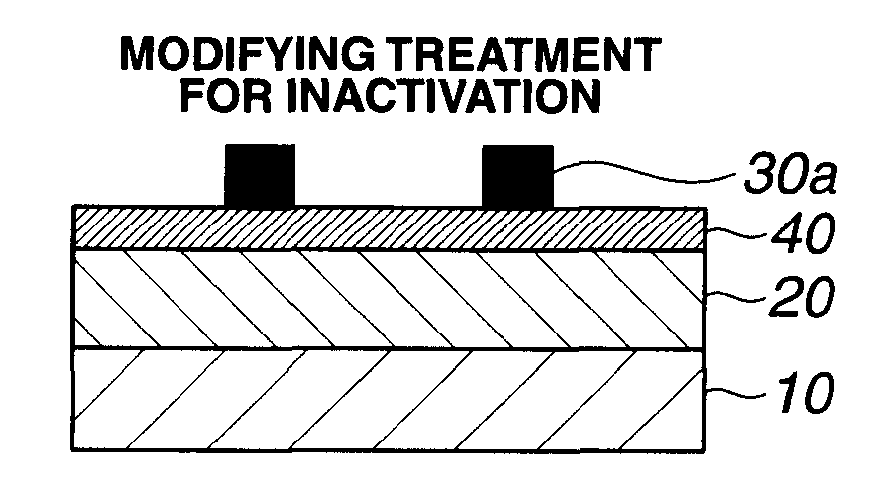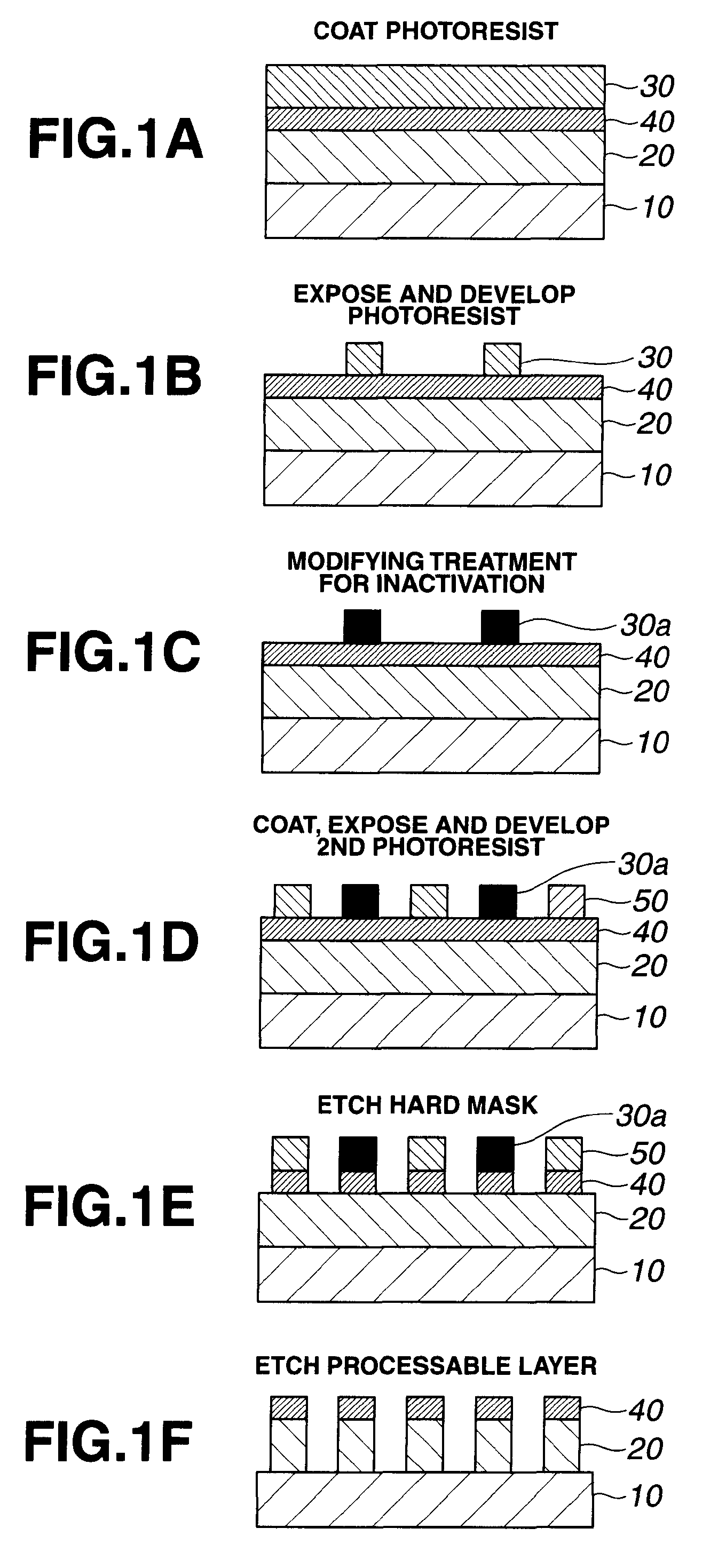Pattern forming process, chemically amplified positive resist composition, and resist-modifying composition
a technology of chemical amplification and composition, applied in the field of pattern forming process, chemical amplification of positive resist composition, composition, etc., can solve the problems of insolubilizing composition, difficult to form an effective pattern feature for alignment, and misregistration of patterns by dry etchings
- Summary
- Abstract
- Description
- Claims
- Application Information
AI Technical Summary
Benefits of technology
Problems solved by technology
Method used
Image
Examples
example
[0226]Examples of the invention are given below by way of illustration and not by way of limitation. The amount “pbw” is parts by weight. Me stands for methyl, and Boc stands for t-butoxycarbonyl.
Preparation of Base Resin for Resist
[0227]Polymers to be used as the base resin in resist compositions were prepared by combining various monomers in 2-butanone medium, effecting copolymerization reaction in the presence of dimethyl 2,2-azobis(2-methylpropionate) as a radical polymerization initiator, crystallization in hexane, repeated washing, and vacuum drying. The resulting polymers (Polymers 1 to 7) had the composition shown below. The composition of each polymer was analyzed by 1H-NMR and 13C-NMR, and the Mw and Mw / Mn determined by GPC versus polystyrene standards.
[0228]
examples 1-1 to 1-4
and Reference Example 1-1 to 1-3
Preparation of First and Second Resist Compositions
[0229]A resist solution was prepared by dissolving each polymer (Polymers 1 to 7) as a base resin, an acid generator, a basic compound, and a repellent (for rendering the resist film surface water repellent) in a solvent in accordance with the recipe shown in Table 1, and filtering through a Teflon® filter with a pore size of 0.2 μm. The solvent contained 50 ppm of surfactant FC-4430 (3M-Sumitomo Co., Ltd.).
[0230]The components in Table 1 are identified below.
[0231]
TABLE 1BaseAcidBasicResistresingeneratorcompoundRepellentOrganic solventcomposition(pbw)(pbw)(pbw)(pbw)(pbw)Example1-1Resist 1Polymer 1PAG 1Quencher 1RepellentPGMEA (2,160)(80)(12.7)(2.0)Polymer 1cyclohexanone (240)(3.0)1-2Resist 2Polymer 2PAG 1Quencher 1RepellentPGMEA (2,160)(80)(12.7)(2.0)Polymer 1cyclohexanone (240)(3.0)1-3Resist 3Polymer 3PAG 1Quencher 1RepellentPGMEA (2,160)(80)(12.7)(2.0)Polymer 1cyclohexanone (240)(3.0)1-4Resist 4Pol...
examples 2-1 to 2-6
and Reference Examples 2-1 to 2-4
Preparation of Resist-Modifying Composition
[0232]Resist-modifying compositions A to J were prepared by mixing a basic nitrogen-containing compound (N1 to N5), aqueous alcohol solvent, a polymer (Polymers 8, 9, shown below), a crosslinker (C1, C2), and a solvent in accordance with the recipe shown in Table 2, and filtering through a Teflon® filter with a pore size of 0.2 μm.
[0233]Polymer 8 is polyvinyl pyrrolidone with Mw=˜10,000 commercially available from Aldrich. N5 and Polymer 9 were prepared by combining various monomers in ethanol solvent, effecting copolymerization reaction in the presence of dimethyl 2,2-azobis(2-methylpropionate) as a radical polymerization initiator, and distilling off the solvent. The composition of each polymer was analyzed by 1H-NMR and 13C-NMR, and the Mw and Mw / Mn determined by GPC versus poly(methyl methacrylate) standards.
[0234]The components in Table 2 are identified below. For reference, a pKa value is reported as t...
PUM
| Property | Measurement | Unit |
|---|---|---|
| pKa | aaaaa | aaaaa |
| refractive index | aaaaa | aaaaa |
| refractive index | aaaaa | aaaaa |
Abstract
Description
Claims
Application Information
 Login to View More
Login to View More - R&D
- Intellectual Property
- Life Sciences
- Materials
- Tech Scout
- Unparalleled Data Quality
- Higher Quality Content
- 60% Fewer Hallucinations
Browse by: Latest US Patents, China's latest patents, Technical Efficacy Thesaurus, Application Domain, Technology Topic, Popular Technical Reports.
© 2025 PatSnap. All rights reserved.Legal|Privacy policy|Modern Slavery Act Transparency Statement|Sitemap|About US| Contact US: help@patsnap.com



